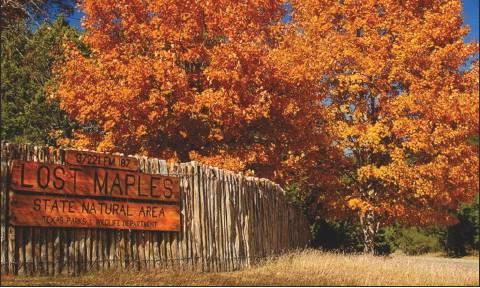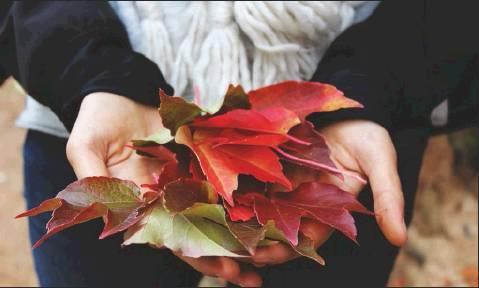Getting Into Gardening
Why do tree leaves change color and shed in fall? I am asked that question every year.
Wouldn’t it be nice to enjoy those brilliant autumn leaf colors all year– rather than for a few short weeks? Maybe so, but the changing leaf color each fall is part of an important and complicated process that ends in their being shed at the end of each growing season. The actual term used to describe this process of leaf drop is known as abscission. Leaves fall as a result of unique cells that separate from each other based on physiological changes
Although some parts of trees like stems and buds can handle freezing temperatures, most leaves cannot. So, in order to protect themselves, trees and plants shed diseased, damaged or dead tissue (namely leaves), while simultaneously sealing the point where the leaf petiole connects to it. Known as the abscission layer, it consists of unique cells that can separate from each other based on certain physiological occurrences. As changing climate and light conditions of autumn evolve, hormones within trees change too. The most notable is auxin. It’s produced in the leaves and body of trees and plants. This balance of auxin levels between leaves and branches is key to determining if and when leaf drop occurs.
During the active growing season, production rates of auxin in leaves are consistent with other parts of the plant or tree. As long as these rates are steady, the cells of the abscission layer remain connected, which in turn, keeps leaves attached, alive, and active. However, as days shorten and temperatures cool, auxin production in leaves starts to decrease in response to changing conditions. As a result, fracture lines develop at the base of the leaf petioles and scarring builds up at the same point to form a protective barrier. Eventually, it’s just a matter of time before wind or rain provides that last nudge and the leaves are released, at least for most trees.
Oaks and beech trees are another story. They hang on to many of their leaves well beyond that of other broadleaf deciduous trees. These brown and tan, dead-looking marcescent leaves cling to branches until newly emerging growth pushes them off in spring.
Although leaves falling in autumn are a predictable event, leaf drop is not only seasonal. Plants and trees can lose their leaves for a number of reasons, namely from drought and other physical or environmental stresses. Although any tree is subject to leaf drop under such conditions, not all trees are considered deciduous or even semi-deciduous. Narrow-leafed evergreens such as fir, hemlock, pine and spruce are able to survive winter without foliage loss for two reasons. First, their leaves develop a protective waxy coating. On top of that, the fluid inside their cells contains a version of nature’s antifreeze. Since the attached foliage remains undamaged, there is no need for it to be shed.
While evergreen trees are beautiful year-round, deciduous trees are desirable for another reason. Their leaves provide vital organic matter and build structure and water holding capacity in the soil. So, each autumn, enjoy and savor the brilliant display of color. And in winter take pleasure in the evergreens. But be thankful for the deciduous trees too, in spite of all the leaves on the ground. They’re doing more good than you might have ever imagined.
In warmer months chlorophyll masks the potential colors of fall. Even if you live in the most tropical of climates, where summer is your only season, you still can’t help but marvel at the splendor of a brightly colored autumn vista. So, what’s behind this annual event? Why do leaves change color every fall and why are some years more vivid in color than others?
To understand what’s involved each fall in the transformation from a sea of cool green to a kaleidoscope of red, orange, yellow and every shade in between, it is helpful to know two important points. The timing of leaf color change is primarily affected by the calendar and the intensity is a product of three main factors: color pigments, length of night and weather.
First are the pigments. There are three most responsible for leaf color. Most of us are familiar with the first, chlorophyll. You know it as having something to do with providing the basic green color found in leaves and grass. It’s required for photosynthesis, the chemical process that allows plants of all sizes to use sunlight to produce food.
During the warmer months when plants are actively growing, the chlorophyll pigment dominates the color we see in leaves. However, another pigment is also present at this time, carotenoids. They produce the yellows, oranges and browns. But because chlorophyll is so dominate as a pigment, it is not until fall, when the photosynthesis process shuts down that carotenoid pigments begin to become apparent. Eventually the photosynthesis process ceases, and all chlorophyll is depleted, eliminating the green color completely from certain leaves and allowing the carotenoid pigments to shine through.
A third pigment, anthocyanins are not present in leaves until autumn. Warm bright days of fall produce lots of sugars in the leaf. But as the days shorten and the nights cool, these excess sugars are trapped in the leaf as veins leading into and out of the leaves gradually close. The combination of bright light and trapped sugars stimulate the production of the anthocyanin pigments. They produce the vivid shades of reds and purple and the many hues in between.
The next factor contributing to fall leaf color is the longer nights. Days become shorter, reducing the amount of sunlight available for plants to photosynthesize. This is nature’s way of signaling plants that winter is on the way. Energy begins to shift from food and energy production into storage and reserves. As the photosynthesis process slows down in response to shorter days, so does the production of chlorophyll. In the absence of the dominant green pigment, carotenoid and anthocyanin pigments light up the fall landscape.
The third factor, the one most responsible for the intensity of autumn color, is the weather. The most brilliant fall displays are the result of a warm wet spring, a mild summer, bright sunny autumn days and cool but above freezing nights. When this combination comes together, the result is the most vivid color exhibition.
So, as you enjoy this season’s display of color, be sure to wish for plentiful spring rains. And next spring, when it’s warm and inconveniently wet, be happy, remember it may just be the makings of the spectacular fall we all want to enjoy!





